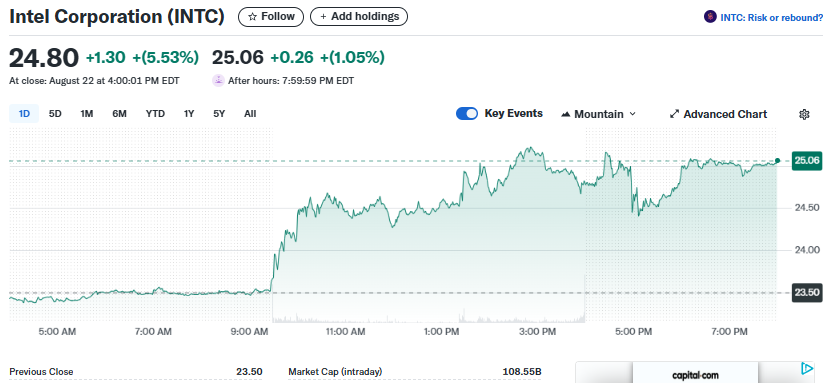TLDRs;
- Intel stock rose 5.53% to $24.80 after Trump confirmed a U.S. government purchase of nearly 10% equity.
- The government will buy 433.3 million shares at $20.47 each, securing a $4 discount below market price.
- Intel faces its first annual loss since 1986, with U.S. support seen as critical to its survival.
- The $8.9B deal reflects Washington’s strategy of backing domestic chip production amid rivalry with China.
Intel Corporation’s stock jumped 5.53% to close at $24.80 on Thursday, August 22, after President Donald Trump confirmed that the United States government will purchase a nearly 10% stake in the company.
The investment, valued at $8.9 billion, marks one of the most significant government interventions in the U.S. technology sector in decades.
According to the announcement, Washington will acquire 433.3 million shares of Intel at $20.47 per share, a discounted price compared to Thursday’s close. The deal is being funded through a mix of unpaid CHIPS Act grants and allocations to Intel’s Secure Enclave program, which is aimed at bolstering secure semiconductor production for national defense and advanced computing needs.
Intel C.E.O and Commerce Secretary Howard Lutnick confirmed that with this purchase, the federal government now effectively owns 10% of Intel, a move that analysts say could reshape the semiconductor industry and its geopolitical dynamics.
Just met with President Trump to announce a historic agreement: the U.S. government is investing $8.9B in @Intel to boost American semiconductor leadership.
I’m excited about the work ahead to ensure the most advanced silicon technology and computing products of the future are… pic.twitter.com/8PUcJyiNJu
— Lip-Bu Tan (@LipBuTan1) August 22, 2025
Intel shares show mixed reaction
While the market initially reacted positively to the news, pushing Intel stock up during trading hours, shares dipped 1.2% in after-hours trading as investors weighed both the benefits and risks of government involvement.

Intel has faced mounting challenges in recent years, including its first annual loss since 1986, reporting an $18.8 billion deficit in 2024 and a Q2 2025 non-GAAP operating loss of $503 million. The company’s once-dominant foundry business has struggled to keep pace with Taiwan’s TSMC and South Korea’s Samsung, forcing Intel to seek external support to remain competitive.
Analysts suggest the U.S. equity purchase provides Intel with financial stability at a critical juncture, but warn that significant hurdles remain in product development, customer acquisition, and regaining market share.
Government support rooted in national security
This investment is part of a broader historical pattern of government–tech partnerships that emerge during times of national security concern. The U.S. government has a long track record of funding technology development when strategic priorities are at stake, dating back to radar and communications research during World War II.
Today, the semiconductor rivalry with China has created similar pressures. By taking a direct stake in Intel, Washington is sending a strong signal that domestic chip manufacturing is now considered critical infrastructure, comparable to energy and defense.
The Biden administration has already committed $4 trillion to industrial policy focused on clean energy and advanced technology. The Intel deal, therefore, fits into a broader policy agenda rather than an isolated intervention.
Financial distress creates leverage for U.S.
The timing of the equity purchase highlights how Intel’s financial struggles created favorable conditions for the government to secure discounted shares. By purchasing at $20.47 per share, well below the market value of $24.80, the U.S. was able to lock in both financial advantage and strategic influence.
For Intel, the cash infusion provides much-needed breathing room to continue its multi-billion-dollar foundry expansion. For Washington, it secures direct oversight of a vital industry at a bargain price.
This dynamic mirrors historical precedents, such as government bailouts during the Great Depression or the 2008 financial crisis, when distressed companies offered the state entry points into industries deemed too important to fail.






